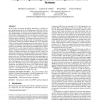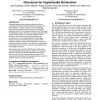411 search results - page 76 / 83 » An Architecture for Transforming Graphical Interfaces |
COMPUTER
2000
13 years 8 months ago
2000
hysical world. How do you adapt software abstractions designed merely to transform data to meet requirements like real-time constraints, concurrency, and stringent safety considera...
VLSI
2010
Springer
13 years 7 months ago
2010
Springer
—Latency insensitivity is a promising design paradigm in the nanometer era since it has potential benefits of increased modularity and robustness to variations. Synchronous elas...
BMCBI
2010
13 years 8 months ago
2010
Background: Most known eukaryotic genomes contain mobile copied elements called transposable elements. In some species, these elements account for the majority of the genome seque...
ASPLOS
2008
ACM
13 years 10 months ago
2008
ACM
In this paper we propose the Merge framework, a general purpose programming model for heterogeneous multi-core systems. The Merge framework replaces current ad hoc approaches to p...
HT
2003
ACM
14 years 1 months ago
2003
ACM
Generating hypermedia presentations requires processing constituent material into coherent, unified presentations. One large challenge is creating a generic process for producing ...


